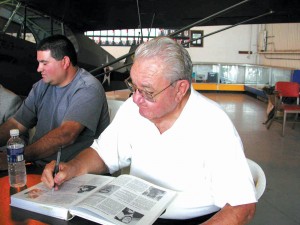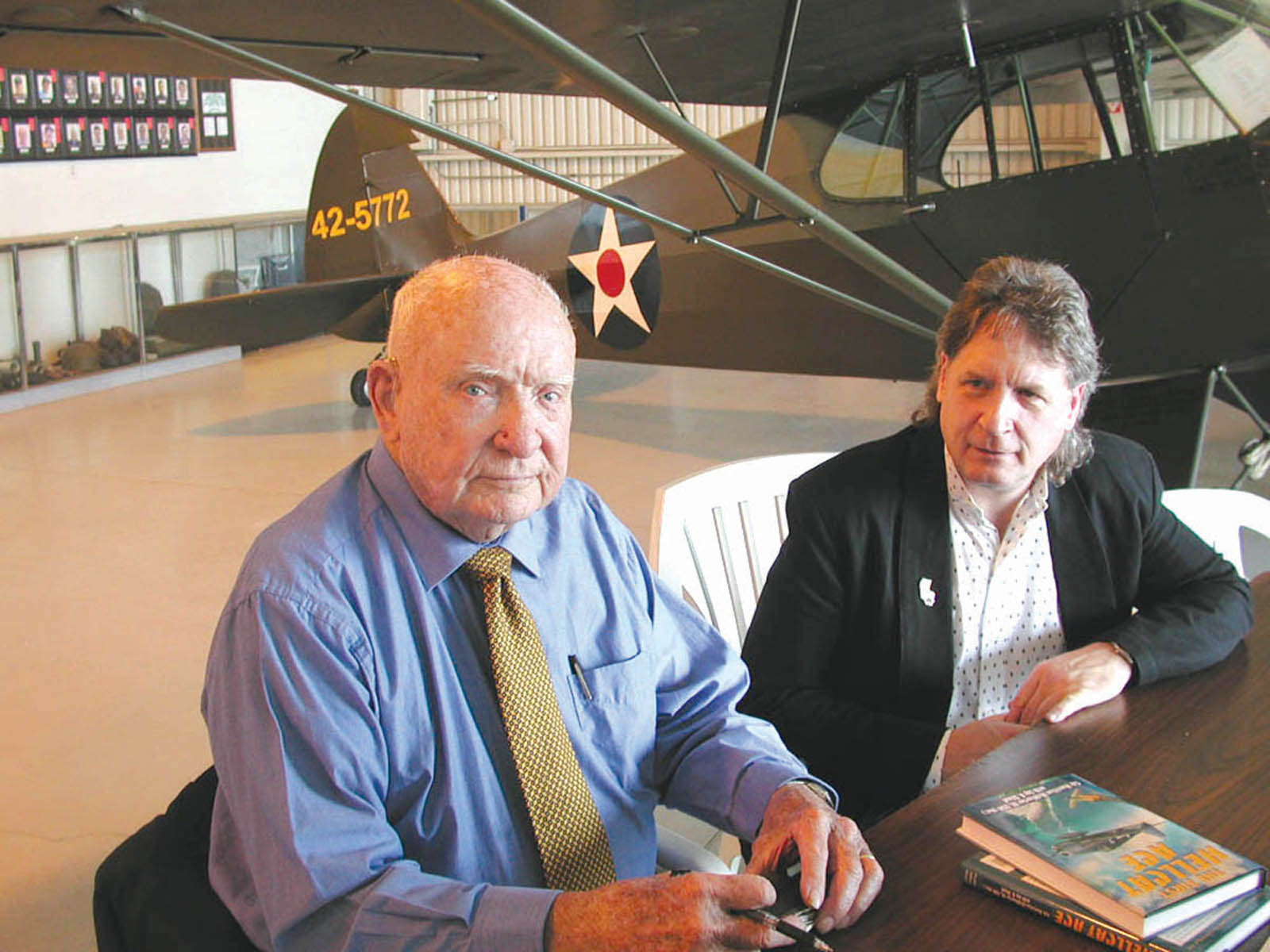By Larry W. Bledsoe

Cdr. Hamilton “Mac” McWhorter signed his book, “The First Hellcat Ace,” after speaking. With him is SCF VP Scott MacWilliams.
What does it take to become an ace? Most people would respond, “Why, five aerial victories, of course.” True, but it’s more than that, as we heard from four aces at the latest Southern California Friends symposium, held October 30 at the Commemorative Air Force’s Inland Empire Wing hangar at Riverside airport. Two 8th Air Force “Mustang” aces and two Navy “Hellcat” aces were the guest speakers.
The first to speak was Maj. William “Bill” Allen. When he arrived in England, he was assigned to fly P-38s with the 343rd Fighter Squadron, 55th Fighter Group, based at Wormingford, England, in April 1944. Allen said two squadrons in the group were located on one end of the airfield where the base services were located, while his squadron was at the other end of the field. Two months later, his outfit transitioned to P-51s.
Allen said that when he arrived in England, a veteran pilot told him that to become an ace, “You gotta be lucky as hell–and have a little skill!” Allen had the skill part down, but to emphasize the lucky part, he went on to say that he flew 87 combat missions but only saw a German aircraft on four of those missions. On only two of those four missions was he close enough to even shoot at an enemy aircraft.
Recalling his first victory, he said they were returning from bomber escort duty when he spotted a German plane down low. He rolled over and dove straight down for the plane. As he was coming up behind it, he was trying to get his gun sight to work. It was a new model that had been installed the night before, and he hadn’t received any instruction on how to use it, and didn’t have a manual to study.
He was still trying to get the gun sight to work when he realized he was coming up on the enemy plane too fast. As he pulled up over the German plane, the enemy pilot spotted him and dove. Since they were down on the deck, the enemy plane flew right into the ground and burst into a ball of flames. Allen said that was his first victory, but they didn’t give him credit for it because he hadn’t fired a shot.
Later, as his flight approached a German aerodrome, Allen spotted a plane taking off, which he identified as an He-111, and shot it down. As he circled around, along came another plane, and he also shot that one down. The same thing happened again and again until he had his five victories, making him an ace-in-a-day. While he identified the enemy planes as He-111s, he was credited with shooting down five trainer aircraft, which is another story.
Allen found out years later that the German pilots had been ordered to take off at two-minute intervals, which made it perfect for him. He was indeed lucky that day. Allen also learned that the German commander had been relieved of his command because Allen had shot the five planes down.
The next to speak was Lt. Cdr. Everett “Carl” Hargreaves, the author of “Son of a Preacher–a Hellcat Ace’s Memoirs.” He recalled that the last time he had spoken before members of the IEW was last January when they were holding a formation-flying clinic. That reminded him of a midair collision he witnessed first hand and up close.
When the USS Enterprise returned from the South Pacific, its fighter squadron, VF-6, had to replace almost half of its pilots who had been lost in combat. In addition, the squadron was also scheduled to transition from the F4F Wildcats to F6F Hellcats.
The Group commander felt that with the transition and the replacement of almost half its pilots, the squadron wouldn’t be ready to ship out with the carrier on its next combat cruise. Consequently, Carl’s squadron VF-2 replaced VF-6 aboard the carrier for that cruise. It was during their first familiarization flight from the carrier a few days later that the accident occurred.
A flight of four aircraft had just taken off from the carrier and were forming up. Hargreaves was the third plane off the carrier and was in the process of forming up when he saw that the second plane was trying to form up much too fast on the lead plane. The result was that the second plane’s propeller chopped the tail assembly off the lead plane.
The lead plane flipped end-over-end down into the sea. Because they were only at about 2,500 feet when the accident occurred, the pilot didn’t have a chance to bail out. Meanwhile, the second plane, which had caused the accident, ended up with the tail assembly of the first plane wrapped around its cockpit, trapping the pilot in the plane as it went down. In a matter of moments, two planes were down, with the loss of both pilots.

Maj. William Allen, former American Fighter Aces Association president, autographs a book for one of the symposium attendees. To his left is Mike Alonzo, SCF VP of operations.
Hargreaves, who is also an ace-in-a-day, knows how luck makes a difference. He had seven months of combat without seeing a Japanese plane. During the Marianna’s Turkey Shoot, he was on combat air patrol over the carriers when the Japanese planes attacked our bombers and the escorting fighter planes decimated the enemy aircraft. In the afternoon, he was escorting bombers when the Japanese attacked the carriers. This was total frustration for him because his squadron mates were becoming aces and he hadn’t even seen a Japanese plane.
But that was soon to change. Shortly thereafter, he was on an escort mission when they met about 20 Japanese fighter planes. He shot down five but only got credit for four due to a problem with his gun camera. Later that afternoon, he was scrambled with three other pilots to intercept an incoming flight of Japanese planes. On that flight he got his fifth confirmed victory for the day.
Commander Hamilton “Mac” McWhorter was up next. “One Slug” McWhorter, who eventually racked up 12 victories, knows about luck too, but in a different way. He flew his first combat missions in Wildcats from the carrier USS Ranger. Later, he became an ace while serving aboard the USS Essex. He details his wartime adventures and close calls in “The First Hellcat Ace.”
McWhorter shared a few of the close calls he had during the war. The first time he was flying off the carrier Ranger during the North African invasion. During one mission, a round came through his canopy and out the back, barely missing his head. When he got back aboard ship, he checked the trajectory of the round and was amazed that it had missed him. He lost several friends and didn’t expect to survive, so every day since then he considers a bonus.
During another time, McWhorter was closing in on the tail of a Japanese plane when he heard what sounded like large rocks hitting a tin roof. He looked up in time to see two Japanese planes on his tail, closing in fast. He immediately rolled over and headed for the deck. When he got back to the carrier, he found bullet holes in his wing that had gone straight down through the wing from top to bottom. Evidently an unseen Japanese pilot above him had fired straight down on him just seconds before other Japanese pilots behind him were ready to fire. He hadn’t seen any of them before the bullets hit his wing and thought it strange that a Japanese pilot had saved his neck.
Another ace at the symposium was Lt. Col. Donald Cummings. Cummings is one of only two pilots who have been credited with downing two German Me-262 jet fighters in a day. In a short, soft-spoken message, he briefly shared with the audience his experiences that day. His message also brought home the point that to achieve this distinction he was lucky to have been at the right place at the right time. Becoming an ace required a lot of skill, as well as a lot of luck, as these four aces’ accounts reveal.











